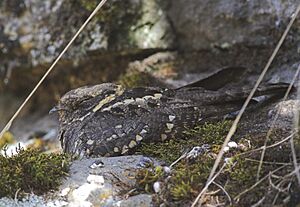Montane nightjar facts for kids
Quick facts for kids Montane nightjar |
|
|---|---|
 |
|
| Conservation status | |
| Scientific classification | |
| Genus: |
Caprimulgus
|
| Species: |
poliocephalus
|
The montane nightjar (Caprimulgus poliocephalus) is a special type of bird. It is also called the mountain nightjar or Abyssinian nightjar. This bird belongs to the nightjar family, known for being active at night. You can find it in the high-up areas of Central and Eastern Africa. It is quite common in these places.
About the Montane Nightjar
A German scientist named Eduard Rüppell first described the montane nightjar in 1840. He gave it the scientific name Caprimulgus poliocephalus. This name is still used today.
Scientists often group animals into smaller categories called subspecies. This helps them understand small differences within a species. The montane nightjar has four main subspecies:
- C. p. poliocephalus: Found from Ethiopia to northern Tanzania, and also in southwest Saudi Arabia.
- C. p. ruwenzorii: Lives in southwest Uganda and the eastern Democratic Republic of the Congo.
- C. p. guttifer: Found in Tanzania, Malawi, and Zambia.
- C. p. koesteri: Lives in central Angola.
One of these, C. p. ruwenzorii, was once thought to be its own separate species. But after studying many museum specimens, scientists decided it was actually just a subspecies. They found that these birds are all very similar.
What Does It Look Like?
The montane nightjar is a fairly dark bird. It grows to be about 23 cm (9.1 in) long. Its feathers are a mix of tawny, blackish, or chocolate brown colors. This dappled pattern helps it blend in with its surroundings.
Male and female nightjars look a little different. The male has white spots on its main wing feathers. The outer edges of its tail are also white. The female has buff-colored spots on her wing feathers. She also has less white on her tail than the male.
This bird has a unique call. It sounds like a nasal ank-ank-ank. This is often followed by a high-pitched whistle, piiiyu-pirrr. The first part of the whistle goes down then up. The second part sounds shaky and goes down.
Where Does It Live?
The montane nightjar lives in Central and Eastern Africa. Its home countries include Angola, Democratic Republic of the Congo, Eritrea, Ethiopia, Kenya, Malawi, Saudi Arabia, Sudan, Tanzania, Uganda, and Zambia.
These birds prefer to live at high altitudes. You can find them between about 1,000 and 3,350 m (3,300 and 11,000 ft) above sea level. Like other nightjars, they are active at night. They hunt for food like moths and other large insects.
Montane nightjars mostly live in forests. However, they can also be found in other places. These include plantations, farm areas near forests, and even in city areas with lots of trees.
Is It Endangered?
The montane nightjar is a common bird. It lives across a very large area. Scientists have not found any major threats to this species. Because of this, the number of these birds seems to be staying steady.
The International Union for Conservation of Nature (IUCN) checks on how well different species are doing. They have given the montane nightjar a "least concern" status. This means that the bird is not currently in danger of disappearing.


